Chapter 6
The C of Procoach:
Commit to Development
“Commitment is an act, not a word.” JEAN-PAUL SARTRE
C: Commit to development Key
Key chapter points
- Your aim during this step is to motivate your coachee to make a change in their working practices, and commit to making this change.
- Different coachees will need different types of objectives. Relative experience and capability will mean variations of objectives will be required across your team
- To achieve the outcomes you wish, consider both results and behaviours during your performance discussion
- Explore with the coachee the reasons for a performance gap. It may be an ability or motivation issue – or both
- Agree a suitable approach to address the performance gap, considering whether you are addressing an ability or motivation issue when choosing the approach
- Help motivate the coachee by asking them to describe an outcome they find inspirational
- Decide whether you will coach an ability or skill issue yourself – or whether it is more appropriate to involve someone else
How do you agree performance goals?
You have built a profile of your coachee’s current performance and have also encouraged them to examine their working practice. You are now ready to begin a coaching conversation with your coachee.
During your coaching conversation you will:
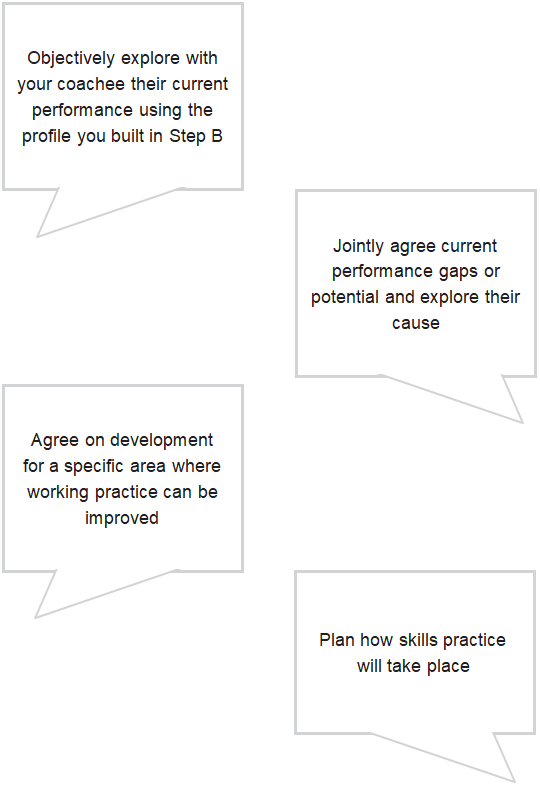
Why is Step C important?
Step C is at the heart of effective performance coaching and alongside Step D is where a significant number of the coaching skills you can learn during a Procoach programme are needed.
If you make effective use of the coaching conversation you will have given the coachee the best opportunity to be both motivated to make a difference to their working practice and make a commitment to the specific development you have discussed with them
Where does Step C fit into the Procoach A-E model?
As you can see from the model’s structure, we regard Step C as central to performance coaching.
Procoach A-E model
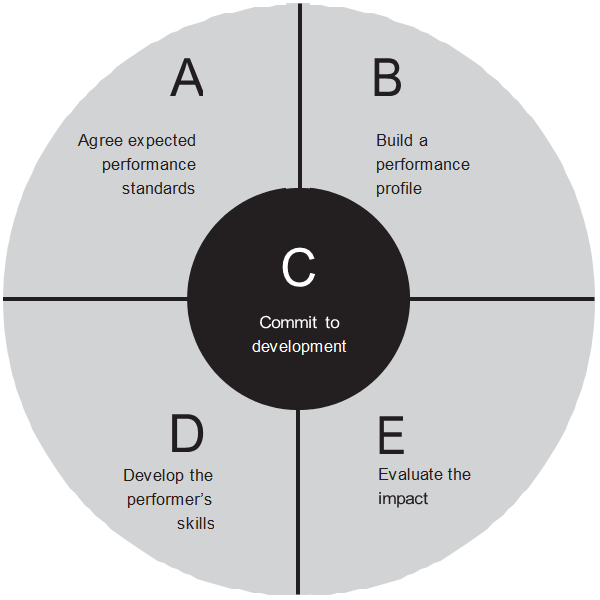
By completing Step C the coachee will have an action plan in line with the standards and performance profile identified and agreed in Steps A and B. At this point you can also check and (if necessary) help the coachee to resolve any motivation or attitude issues that are preventing them from making changes to their skills or knowledge levels.
It is important to note that skill development does not take place during Step C. This is the purpose of Step D, which we describe later.
Explaining Step C
During Step C we identify and agree performance opportunities and how to address these.
The criteria we use during Step C to provide a best practice structure to the coaching conversation is laid out below.
Step C structure and criteria
As with the earlier Steps, these assessment criteria form the basis on which we determine whether a coach has reached our Procoach standard.
Effective delivery of Step C is a combination of the structure shown with the appropriate balance of the behavioural skills.

The structure of Introduction, Body and Summary should be upheld and the discussion of strengths should precede that of development needs. However the precise sequence of some steps needs to be determined by the need for a relaxed and conversational tone to the meeting.
For example you might:
- Encourage the coachee to discuss development areas at more than one point in the conversation
- Ask the coachee to share their views about specific aspects of their performance at several stages of the conversation
You might find it helpful initially to have this structure to hand so you can check during a coaching conversation that you are including all the relevant elements. The structure will particularly help during your self-analysis. Use it to decide whether your coaching helped your coachee to be clear about what they have discussed with you, and how you jointly arrived at conclusions.
Behavioural skills
As outlined in Chapter 3 there are six behavioural skills we recommend as effective in a coaching conversation.
These behavioural skills can be applied to both Steps C and D of the coaching process.
Our 30 years of experience has enabled us to determine the proportions you should expect to see of each behaviour during an effective coaching conversation.
Asking | Proportion of your conversation |
|---|---|
Drawing out 12 - 40% | |
Confirming 12 - 25% | |
Challenging 0 - 10% |
Telling | Proportion of your conversation |
|---|---|
Supporting 8 - 18% | |
Guiding 2 - 35% | |
Releasing tension 0 - 5% |
Each coaching conversation will be different, but as a guide, we regard a 3:2 ratio between asking and telling behaviours as an effective balance.
Types of performance objective
As previously mentioned, there are two reasons to set a performance objective:
- To close the gap between required performance and actual performance.
- To help a coachee achieve their full potential above and beyond role requirments
The type of objective you agree will be determined by the nature of development sought.
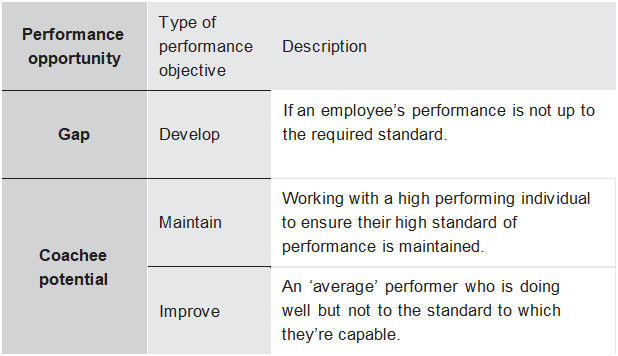
We find that many managers focus on the first two performance areas. However driving improvement with ‘average’ performers delivers the most significant results in terms of team performance so should not be overlooked.
Explore performance
Having agreed which aspect of the coachee’s performance you wish to discuss, you can explore the coachee’s current attainment and which element of working practice they need to adjust.
What makes up performance?
Performance comprises both results (what we want our people to do) and behaviours (the way we want them to do it). You may need to agree both to get the outcomes required.
Results will consist of metrics such as: | Behaviours include: |
|---|---|
|
|
The causes of performance gaps and the opportunity to release coachee potential?
The ability of an individual to deliver the results required of them, or to realise their full potential, can be attributed to four things:
- Their skills
- Their knowledge
- Their mindset
- The environment and resources available
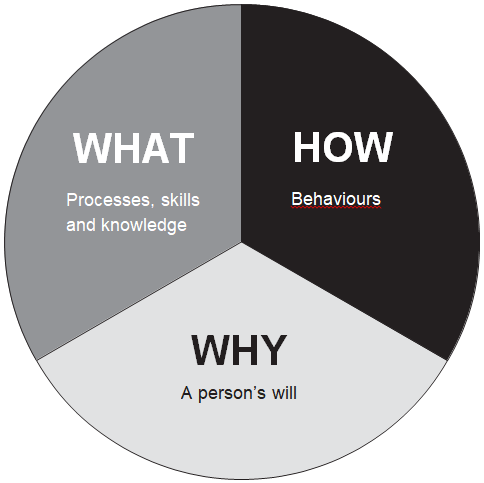
In the coaching conversation, it is the role of the coach to uncover, in association with the coachee, which combination of these factors, when altered, will lead to the realisation of the objectives set.
“Believe in yourself! Have faith in your abilities! Without a humble but reasonable confidence in your own powers you cannot be successful or happy.” NORMAN VINCENT PEALE
A suitable solution for mindset and ability needs
One of the hardest things to determine as a coach is whether a shortfall in performance is due to mindset or skills/knowledge.
The table below provides some questions you can ask yourself to determine whether there is an ability or motivation need – or both.
Ability | Behaviours include: |
|---|---|
A quantitative measure of knowledge, skills or ability to perform the role Questions you would ask yourself:
| A group of qualitative measures and opinions about a person’s approach to their role Questions you would ask yourself:
|
If a lack of motivation or attitude is limiting a coachee’s performance then you need to bring this into the open and identify its cause. This should always be resolved before attempting any development of a coachee’s ability. In other words, you need to discuss and resolve any opportunities to improve motivation during Step C, before moving onto Step D, where skill coaching takes place.
This approach ensures there is ‘ownership’ of the need to improve and a willingness to succeed. This also gives you an opportunity to work on or enhance knowledge, skills or ability through development activities.
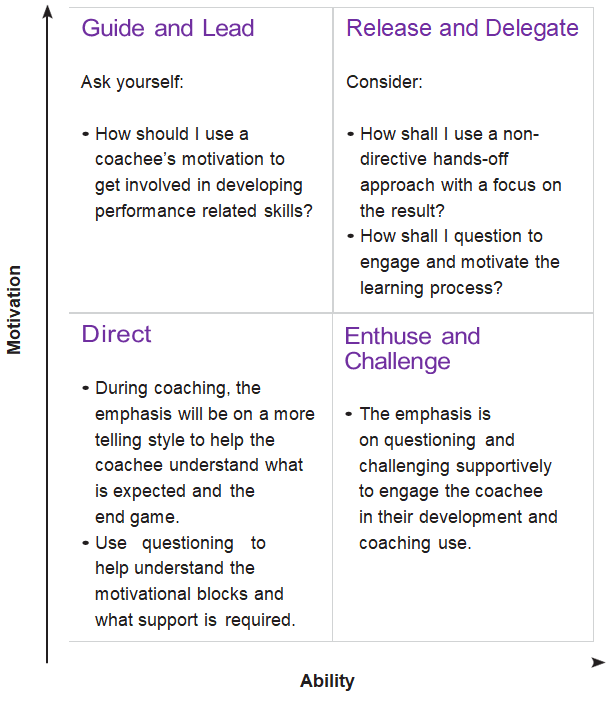
Techniques to reflect a coachee’s ability and motivation
Depending on the level of ability and motivation present, different techniques are suitable. We’ve suggested four approaches here:
Case Study
David examines his application of Step C with Emma:
David examines his approach to Step C.
Firstly he assesses the type of performance objective he had agreed with Emma. True, she was struggling to structure her reports clearly, but she had the key skills. So he saw the objective as one of improvement, to address her decreased productivity as a result of the phone calls.
Looking at the two parts of her performance, results and behaviours, David swiftly concluded that Emma’s needs related to a skill issue. Emma had proved from her conversations with David that she was very willing to grow and become an increasingly valued team member.
In terms of David’s approach to her development areas he considered that his approach to encourage Emma to organise her own development was right.
He regarded her ability and motivation as high, she simply needed a few tips from Jan to modify her report writing skills.
In all David concluded, he had provided the right sort of coaching for Emma.
“The difference between the impossible and the possible lies in a man’s determination.” TOMMY LASORDA
DEFINITION |
|---|
Motivational goals: A goal that the coachee regards as important. |
Motivational goal setting
Once you have identified a performance gap and its cause, you need to agree a goal that the coachee is willing to work towards and achieve.
This is where motivational goals come in. Motivational goals are those that the coachee regards as important.
What type of goal would motivate you?
It is likely that these types of goals would be motivational:
- One you had decided to aim
- One that means a lot to you
- One you had committed to, because you wanted the result.
What type of goal may never get reached?
There are many reasons for not achieving goals. Here are a few reasons why this might happen. The goal:
- Was someone else’s, provided to
- Seems OK, but you lose interest
- Appears impossible or is unclear, which de-motivates
“What lies behind you and what lies in front of you, pales in comparison of what lies inside of you.” RALPH WALDO EMERSON
An “inspirational outcome”
An inspirational outcome is essential to helping the coachee improve their performance. Defining the outcome with your coachee and asking them to put it into their own terms helps them to directly relate to what success feels like.
When working with a coachee to create an inspirational outcome, ask these four questions:
STEP 1 |
|---|
What do you want specifically (a positive statement)? |
STEP 2 |
|---|
When, where and with whom do you want it? (timing & context) |
STEP 3 |
|---|
Where are you now in respect of the outcome you seek? |
STEP 4 |
|---|
What will you be seeing, hearing, and feeling when you get it? |
KEY ADVICE |
|---|
Inspirational outcomes are “well-formed”. In other words, they make the goal agreed with the coachee desirable and achievable, by making the goal real to the coachee – and something they connect to kinesthetically. |
Planning the skills practice
Although you may not carry out skills practice during Step C, you should discuss and agree with the coachee how this will happen in Step D. This means the coachee has contributed, understands and has agreed to how skills coaching will take place. Having also accepted the area in which
to focus their performance development efforts means there is a firm commitment to development.
We regard skills coaching as an essential part of a manager’s performance coaching role. This of course is with the caveat that the manager can only expect to provide coaching for skills if they possess a level of knowledge in this area.
KEY ADVICE |
|---|
A manager can suggest one-to-one and group coaching sessions, when planning skills development. Group coaching can help if a few people in the team have similar development requirements. It allows the manager to reinforce a consistent, best practice approach across the team. |
Choosing when to provide skills coaching directly
It is important to note at this point that we are not looking for the manager to have expertise or a depth of knowledge. In performance coaching situations, the coach simply needs enough knowledge to be in a position to help the coachee improve their skills.
As an example of this, a manager of a sales team should be in a good position to offer performance coaching practice on subjects such as selling and account management skills. They should both know what best practice looks like and at a high level how the team puts these skills into practice.
There will be some skills for which a manager cannot offer direct coaching support. Perhaps the sales manager doesn’t know, in sufficient detail, how to use their customer relationship management system to record orders. Or the performance gap or potential might involve skill practice in an area that doesn’t directly relate to sales skills.
In this situation, a manager would need to consider who might provide this support. For example, other team members might be better placed to provide coaching practice. Perhaps someone outside the team, within or external to the organisation would be in better position to provide this support. Some development areas might also benefit from self-directed learning. Books, journals, white papers and the web offer many support options that might be suitable. Whichever method(s) of coaching support you choose, it is essential to agree an approach that provides the best opportunity to benefit the coachee.
KEY ADVICE |
|---|
|
Case Study
David uses the Step C guidelines
David and Emma are meeting for the first time since Emma received some help from Jan to structure her reports more clearly.
David is determined to follow the Step C guidelines to help Emma get the most from their session.
He begins by having a general chat to Emma, allowing her to relax before outlining what he would like to discuss during the meeting and asking for her confirmation that this is what Emma would also like to cover.
They then begin to discuss the report writing skills she has learnt. Emma is very enthusiastic, explaining that Jan gave her some really good, clear guidelines and that her reports had improved significantly as a result. She has noticed that it takes her less time to write each report and the calls have dropped to a manageable level.
David congratulates her and confirms that he has noticed the difference. Her ability to increase her workload is really helping the team.
He then moves on by prompting Emma for other areas where she feels she can improve.
After some hesitation, Emma asks if it is possible to attend a Word Processing course.
After some discussion, David gathers that Emma feels that she can increase her productivity further. Emma finds it particularly difficult to format data from different sources into a single document. They discuss the options available and agree that Emma can pick up some of the skills from Jon, another team colleague. With some prompting, Emma suggests that she will set an agenda for Jon, so he can prepare in advance of their session. Then if she requires more advanced skills, they will look into a tailored course, which would address specific areas. David summarises their decisions and actions, checking that Emma is committed to setting up her session with Jon. Emma writes up the summary and they agree a follow up date, to review her progress.
Chapter check
What have you learnt from this chapter?
Check your knowledge by answering these questions:
Self-assessment questions
- What three types of performance objective might you set with your coachee?
- Which factors contribute to a person’s performance?
- What type of action might be appropriate if a coachee’s performance relates to a mindset issue?
- As a coach, can you adapt your techniques to match the different levels of ability and motivation in your coachee?
- What are the three main stages of the step C structure?
Chapter 6 – Summary & Actions
In this chapter we recommended the following:
- Motivate your coachee to make a change in their working practices, and commit to making this change, by involving them.
- Agree different types of performance objective to reflect capabilities of the coachee
- To achieve the outcomes you desire, consider both results and behaviours during your performance discussion
- Explore with the coachee the reasons for a performance gap. It may be an ability or motivation issue – or both
- Use a suitable approach to address the performance gap, considering whether you are addressing an ability or motivation issue
- Motivate the coachee by asking them to describe an outcome that they find inspirational.
- Decide whether you will develop an ability or skill issue yourself, or whether it is more appropriate to involve someone else
Your action plan
Consider the actions you will take to encourage performance improvement in your team, department or organisation.
Ask yourself:
- How do you currently discuss and agree performance gaps? Are there any aspects that you could improve?
- What objectives do you currently agree with your coachee? Are they suitable for their current performance levels?
- How can you improve your diagnosis and response to an ability or motivation issue?
- Are the goals you set inspirational for your coachee?
- How do you decide on the most appropriate person to address an ability or skill issue?
Make a note of any aspects that you feel you can improve. Then plan how to make a start on the areas you have identified.
